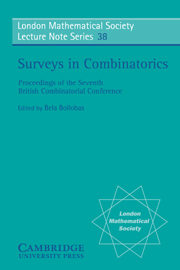Book contents
- Frontmatter
- Contents
- PREFACE
- 1 Resonance and reconstruction
- 2 Symmetry conditions in graphs
- 3 Extremal hypergraph problems
- 4 Connectivity and edge-connectivity in finite graphs
- 5 Partition theory and its applications
- 6 Strongly regular graphs
- 7 Geometries in finite projective and affine spaces
- 8 Long cycles in digraphs with constraints on the degrees
- 9 Colouring problems and matroids
- Index
9 - Colouring problems and matroids
Published online by Cambridge University Press: 17 March 2010
- Frontmatter
- Contents
- PREFACE
- 1 Resonance and reconstruction
- 2 Symmetry conditions in graphs
- 3 Extremal hypergraph problems
- 4 Connectivity and edge-connectivity in finite graphs
- 5 Partition theory and its applications
- 6 Strongly regular graphs
- 7 Geometries in finite projective and affine spaces
- 8 Long cycles in digraphs with constraints on the degrees
- 9 Colouring problems and matroids
- Index
Summary
INTRODUCTION
One of the attractions of matroid theory is that it usually provides several different natural settings in which to view a problem. The theme of this paper is the use of matroids to relate problems about colourings and flows in graphs with problems of projective geometry.
Veblen in 1912 was the first to attempt to settle the four colour conjecture by geometrical methods. In the same year G.D. Birkhoff tried to settle it by an enumerative approach. Despite, or perhaps because of, their lack of success their work led to some startling extensions, notably by W.T. Tutte. Following on from Veblen's work, Tutte in 1966 formulated a fascinating geometrical conjecture – namely that there were just three minimal geometrical configurations which had a non empty intersection with each coline of PG(n,2) (he called them tangential 2-blocks). As a result of his work on enumerating polynomials Tutte in 1954 was led to make a series of equally fascinating conjectures about flows in directed networks. One of these was recently proved by F. Jaeger in 1975, when he gave a very elegant proof that every bridgeless graph has an 8-flow – equivalently every bridgeless graph is the union of three Eulerian subgraphs. Even more recently a remarkable advance towards the solution of Tutte's tangential block conjecture was made by P.D. Seymour when he showed that the only new tangential blocks must be cocycle matroids of graphs. This reduces a seemingly intractable geometrical question to the conceptually easier problem of classifying those graphs which cannot be covered by two Eulerian subgraphs.
- Type
- Chapter
- Information
- Surveys in Combinatorics , pp. 229 - 258Publisher: Cambridge University PressPrint publication year: 1979

